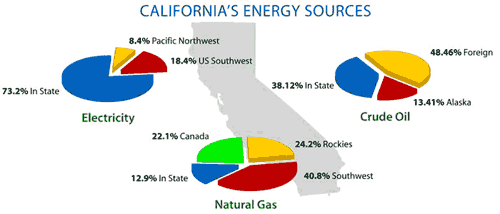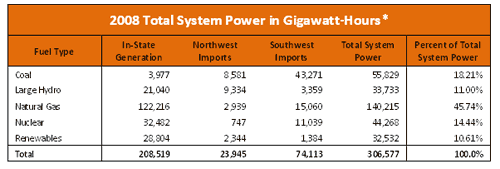California’s Energy Usage
According to the latest statistics, there are nearly 37 million people in California. Although population growth has slowed in recent years, the California Department of Finance estimates that by the year 2050, there will be 60 million people living in California. (This estimate varies greatly depending upon the source agency.)
So, just how much power do 37 million people need?
The CEC reports that, in 2008, Californians used 285,574 gigawatt hours of electric power. That’s an enormous demand for electricity – one that will only continue to grow as population increases.
1,000 watts = 1 kilowatt (kW)
1 million watts = 1 megawatt (MW)
1 trillion watts = 1 gigawatt (gW)
1 million kilowatt-hours (kWh) = 1 gigawatt-hour (gWh)
A kilowatt-hour (kWh) is equal to the energy of 1,000 watts working for one hour.
A gigawatt-hour (gWh) is equal to the energy of 1 trillion watts working for one hour.
California’s Energy Sources
 Currently, California generates 73 percent of the electric power it needs in-state; the remainder is imported from Arizona and Nevada in the Southwest and Oregon and Washington in the Northwest.
Currently, California generates 73 percent of the electric power it needs in-state; the remainder is imported from Arizona and Nevada in the Southwest and Oregon and Washington in the Northwest.
The following chart illustrates the breakdown of total system power in California by fuel type, in-state generation and Northwest and Southwest imports.

*From CEC 2008 Net System Power Report
Power Transmission and Distribution
In order to get this power from the generators to customers, California relies on 75 transmission and distribution organizations or load serving entities (LSEs), including:
- 48 Publicly Owned Utilities – including Sacramento Municipal Utilities District, Modesto Irrigation District, and the Los Angeles Department of Water and Power
- 6 Investor-Owned Utilities – including Pacific Gas & Electric, Southern California Edison and San Diego Gas & Electric
- 4 Rural Electricity Cooperatives – including Plumas-Sierra Rural Electric Cooperative
- 3 Native American Utilities
- 14 Other Electricity Service Providers
Meeting Current and Future Energy Needs
These utilities and providers, including TANC’s members, obtain electricity from California’s transmission system, a system that is currently overutilized and at risk of not meeting the state’s energy need. For more information on the state of California’s transmission system see -Reports and Studies.
California’s Goal for Renewable Power Supply
To meet our state’s current and future energy needs, California’s utilities and electricity providers must access more electricity sources – particularly renewable sources – which means more transmission lines will be needed in the state. According to the CEC, “inadequate transmission infrastructure” needed to connect remotely-located renewable resources is one of the top five barriers to achieving California’s aggressive RPS requirement to generate 33 percent of its power from renewable sources by 2020.
Planning for the Future
To meet the state’s RPS and greenhouse gas emission reduction goals over the next ten years, the California Public Utilities Commission (CPUC) projects that 11 new transmission lines will be needed at an estimated cost of $16 billion – only three of these lines are currently under development.
The magnitude of the infrastructure California will have to plan, permit, procure, develop and connect with the state’s electricity power grid in the next decade to meet the RPS target of 33 percent is unprecedented. If implementation were to start today, the needed scale of transmission and generation buildout will take at least 14 years to complete.
